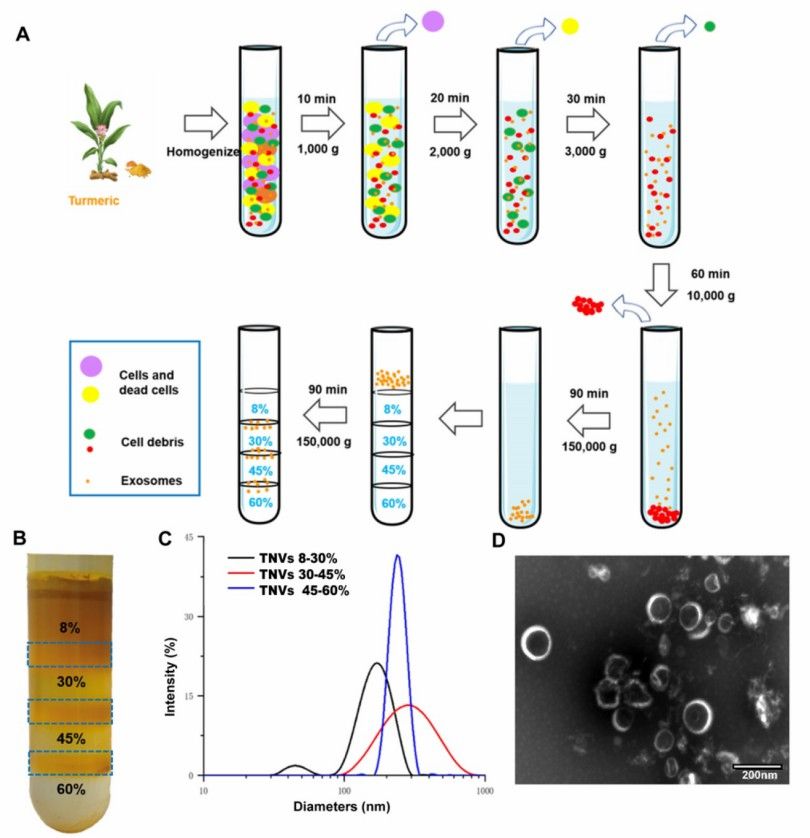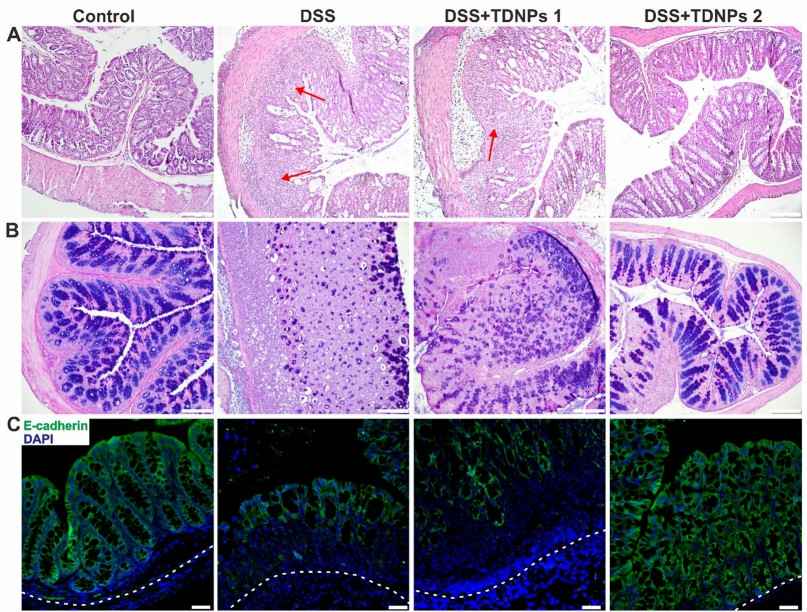Turmeric Root-derived Exosome Research and Application
Turmeric root exosomes have shown favorable efficacy in edible and anti-inflammatory activities in a variety of studies, with promising clinical translational potential. Creative Biolabs can provide customized services related to the development and study of exosomes derived from turmeric roots, facilitating the expansion of the application scope of turmeric root exosomes.
Exosome Isolation from Turmeric Root Origin
-
Collect fresh turmeric and wash it well
-
Homogenize turmeric with a grinder
-
Remove large turmeric tissue and fibers by multiple differential centrifugation to obtain turmeric juice
-
Ultracentrifugation of turmeric juice to obtain precipitate of turmeric root exosomes and resuspension with PBS.
-
Purify turmeric root exosomes by sucrose density gradient centrifugation of the suspension of turmeric root exosomes.
 Fig. 1 Exosomes obtained from turmeric.1
Fig. 1 Exosomes obtained from turmeric.1
Components of Turmeric Root-derived Exosomes
-
Lipidomic analysis of turmeric root-derived exosomes by liquid chromatography-mass spectrometry showed that common vesicular lipid components including phosphatidic acid and phosphatidylinositol are also present in turmeric root-derived exosomes, contributing to the formation and maintenance of their vesicular structure.
-
Proteomic profiling of turmeric root-derived exosomes revealed that the proteins they contained were associated with processes involved in molecular functions, metabolic pathways, and the synthesis of secondary metabolites.
-
High-performance liquid chromatography analysis revealed that turmeric exosomes purified from 30-45% sucrose interface contained high levels of curcumin.
Studies on Turmeric Root-derived Exosomes
|
Study Item
|
Conclusion
|
|
Biodistribution of turmeric root-derived exosomes
|
-
The size and dispersion coefficient of turmeric root-derived exosomes in PBS, gastric, and intestinal fluids did not change significantly, indicating stable performance in harsh environments.
-
After oral administration, turmeric root exosomes selectively localized and enriched in inflamed colonic lesion areas with the potential to target colitis.
-
Cellular uptake assays demonstrated that turmeric root exosomes are able to be taken up by macrophages and intestinal epithelial cells, which are reliant on multiple uptake mechanisms.
|
|
Anti-inflammatory activity of turmeric root exosomes
|
Turmeric root exosomes inhibited lipopolysaccharide-induced elevation of macrophage proinflammatory factors, and this modulatory effect was associated with the induction of macrophage polarization to the M2 phenotype.
|
|
Efficacy of turmeric root exosomes in colitis
|
-
In the dextran sulfate sodium-induced mouse model of ulcerative colitis, turmeric root exosomes were able to alleviate colon shortening associated with inflammation and protect the integrity of the intestinal mucosa.
-
Ulcerative colitis mice administered with turmeric root exosomes had the highest scores on the Disease Activity Index and showed significantly reduced inflammation-related features such as neutrophil and macrophage infiltration to modulate colonic immunity.
-
Turmeric root exosomes preserved the intact intestinal barrier in colitis mice by preventing the reduction of tight junction-associated protein expression.
-
Turmeric root exosomes displayed therapeutic efficacy and translational potential in both acute and chronic colitis mouse models.
|
|
Turmeric root exosomes reinvent the gut microbiota
|
Turmeric root exosomes increase the abundance and diversity of intestinal flora. Oral administration of turmeric root exosomes increased the relative abundance of Akkermansia, Lactobacillus, and Bifidobacterium in the mouse intestinal flora, while the relative abundance of Bacteroide, Helicobacter, and Staphylococcus decreased.
|
 Fig. 2 Histologic staining assessment of the ameliorative effect of turmeric exosomes on colitis.2
Fig. 2 Histologic staining assessment of the ameliorative effect of turmeric exosomes on colitis.2
Applications of Turmeric Root Exosomes
-
Exosomes extracted from turmeric roots have morphological and structural features similar to those of exosomes from other sources and can be used as drug carriers for loading and transporting drugs to target cells or tissues to improve the efficacy and safety of drugs.
-
Benefiting from the potential to carry a variety of active compounds such as curcumin from its donor source to exert pharmacological effects, turmeric root exosomes have hypolipidemic, anti-inflammatory, antitumor, antioxidant and other potentials, and can be used in therapeutic studies for a wide range of diseases, such as colitis, tumors and so on.
Naturally occurring nanovesicles with exosome-like structures containing active molecules such as curcumin, intracellular proteins, and nucleic acids have been isolated from turmeric roots that exhibit excellent therapeutic potential as an oral formulation in a model of colitis. Creative Biolabs offers comprehensive exosome services to provide effective support and rationale for the research and translation of exosomes derived from turmeric roots. Please contact us to advance your exosome project.
References
-
Gao, Caifang, et al. "Turmeric-derived nanovesicles as novel nanobiologics for targeted therapy of ulcerative colitis." Theranostics 12.12 (2022): 5596.
-
Liu, Cui, et al. "Oral administration of turmeric-derived exosome-like nanovesicles with anti-inflammatory and pro-resolving bioactions for murine colitis therapy." Journal of Nanobiotechnology 20.1 (2022): 206.
For Research Use Only. Cannot be used by patients.
Related Services:

 Fig. 1 Exosomes obtained from turmeric.1
Fig. 1 Exosomes obtained from turmeric.1
 Fig. 2 Histologic staining assessment of the ameliorative effect of turmeric exosomes on colitis.2
Fig. 2 Histologic staining assessment of the ameliorative effect of turmeric exosomes on colitis.2









